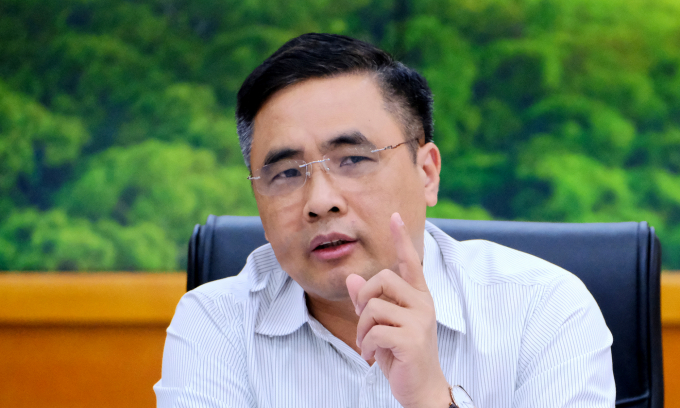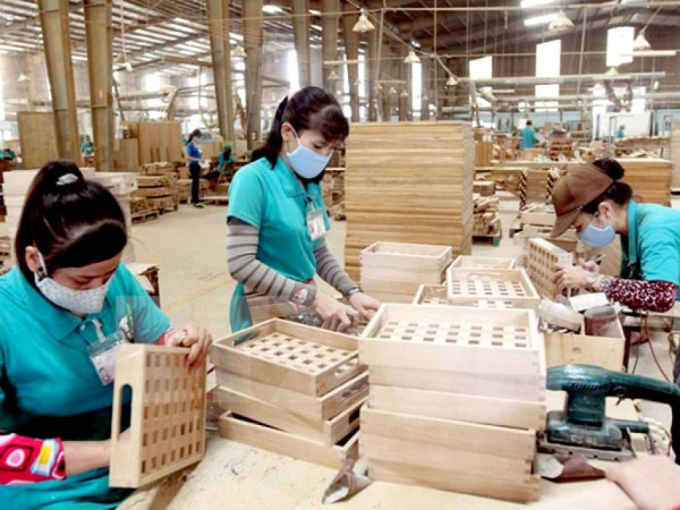November 25, 2025 | 06:11 GMT +7
November 25, 2025 | 06:11 GMT +7
Hotline: 0913.378.918
November 25, 2025 | 06:11 GMT +7
Hotline: 0913.378.918
At the conference to review the performance of the General Department of Forestry in the first half of this year and its tasks for the second half of 2022, Director General Nguyen Quoc Tri said that Party, State and people paid attention to forest protection activities.

Director General of the General Department of Forestry Nguyen Quoc Tri said that difficulties of forest rangers had been reported to the Government. Photo: Bao Thang.
Recently, leaders of the General Department of Forestry reported "bottlenecks" in mechanisms and policies for forest rangers to the Government including harsh working conditions, high risk of exposure to forest fires. The General Department also proposed a number of support policies to address the bottlenecks.
Director of the Forest Protection Department Nguyen Huu Thien said that the forest ranger force had a big workload, each ranger has to be in charge of several tens of ha, even a few hundred ha forest. Forest rangers were still busy with administrative work.
"On average, every day, we have to process and issue about 13 documents, from direction and administration to legal documents," said Thien.
According to the leader of the Forest Protection Department, in the first half of 2022, the number of forest violations decreased by 1.2 per cent over the same period, the damaged forest area decreased by 50 per cent over the same period; the number of forest fires decreased by 65 per cent over the same period. However, there were still some hot spots for deforestation in some provinces in the Northwest, Central Highlands and Central regions.

The forestry industry faces many difficulties and opportunities in the second half of 2022. Photo: Bao Thang.
To strengthen forest protection, ensure the life of forest rangers, Director General Nguyen Huu Thien said that the forest ranger system at all levels need more modern equipment such as fire watchtowers attached to sensors, improved capacity building, multi-value integration in line with the development orientation by the Ministry of Agriculture and Rural Development.
In addition to maintaining a stable forest coverage of 42 per cent and improve forest quality, the forestry sector also strives to fulfill the export target of US$16.3 billion assigned by the Government.
Deputy Director General of the General Department of Forestry Pham Van Dien said that it was a possible goal. Dien explained that in the first six months of this year, the wood industry's export reached about $9.1 billion; the area of forest certified for sustainable forest increases steadily and will reach 90,000 ha by the end of the year.
However, he said that challenges, including the world situation such as the Russia-Ukraine conflict, rising inflation in many countries, caused a decrease in demand for wooden furniture in the short term, and the increase of the prices of materials and transportation. Moreover, countries have been implementing protectionist policies.

The forestry sector is confident with its furniture export turnover targets.
"Units of the General Department of Forestry need to closely coordinate with businesses and associations to develop a variety of scenarios to timely offer recommendations relating to the market, ensuring that timber used for production is legal. Thereby, businesses avoid situations related to anti-dumping as well as legal troubles", Dien expressed.Director General Nguyen Quoc Tri affirmed the industry's export targets. In parallel with diversifying the market and increasing the use of domestically planted timber, businesses need to promote domestic consumption so that "people who have products and people who have demand could meet each other."
Tri also asked the whole forestry industry to switch from a management mindset to a service mindset. He emphasised that the implementation of policies should be flexible and compliant with legal regulations.
In addition, Tri suggested a shift from forestry production thinking to forestry economy. He proposed that household forest owners should be further empowered, effectively implementing the policy of payment for forest environmental services, increasing income for people and units involved in forest protection.
In the first six months of 2022, the whole country prepared 859 million seedlings, equaling 130.4 per cent compared to the same period in 2021. Of them, nine new varieties of forestry plants were recognised. The afforestation area reached 119,400ha, reaching 49 per cent of the plan, equaling 103.1 per cent over the same period in 2021. The whole country planted 50 million trees, reaching 41 per cent of the plan, equaling 141 per cent over the same period in 2021.
The trade surplus of the whole industry is estimated at $7.5 billion, up 3 per cent over the same period in 2021. The total payment for forest environmental services is over VND1.5 trillion, equaling 106 per cent of the same period and 54 per cent of the plan.
Translated by Hien Anh

(VAN) Viet Nam is entering the pivotal period of 2025-2030, moving toward the formulation of the Remote Sensing Law, which will establish a legal foundation for the development of national digital data.

(VAN) The agricultural sector is finalizing the strategic framework for emission reduction, setting the goal of sharply cutting methane and 403.7 million tons of CO2 equivalent and moving toward Net Zero by 2050.
/2025/11/22/2236-1-153832_483.jpg)
(VAN) The National Marine Spatial Planning is opening up opportunities for sustainable blue sea development across 21 coastal localities.

(VAN) Viet Nam’s forestry sector is undergoing a comprehensive transformation, strengthening management, protection, and development efforts to maintain ecological security and drive green, sustainable growth.

(VAN) Viet Nam is accelerating efforts to digitize reservoir operations, from real-time data to hydraulic modelling.
/2025/11/21/3348-2-102623_454.jpg)
(VAN) National Assembly delegate Nguyen Thi Lan has proposed adding special mechanisms to attract human resources to the agricultural, forestry, and fishery sectors, addressing the shortage of high-quality personnel.

(VAN) Over the past two decades, the unified legal framework for water resource management has been perfected, becoming a crucial foundation for ensuring national water security.